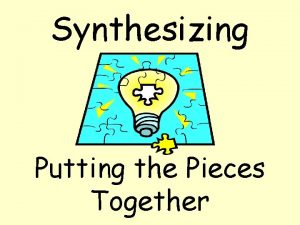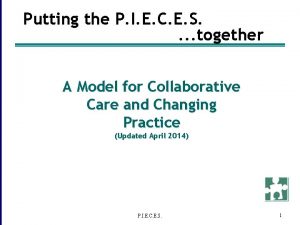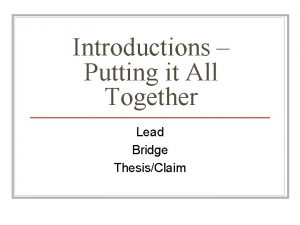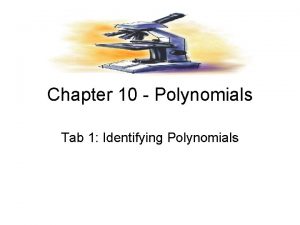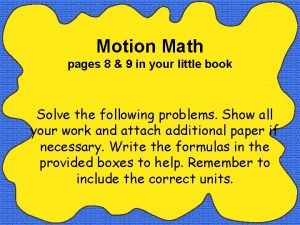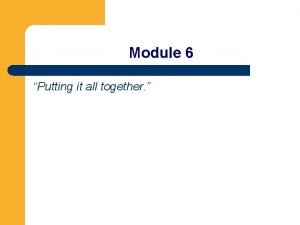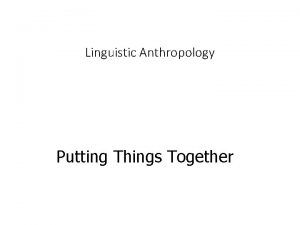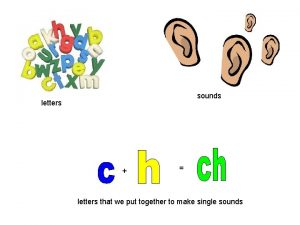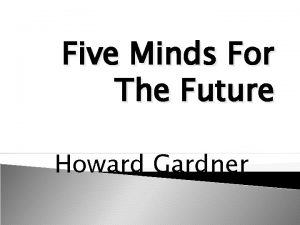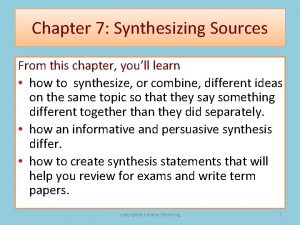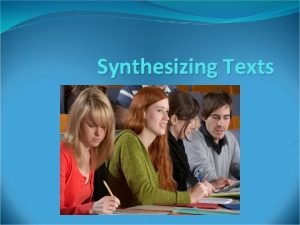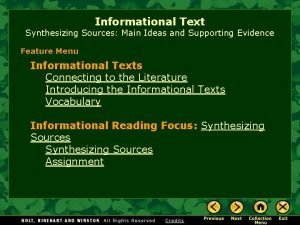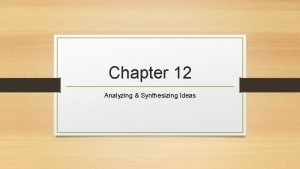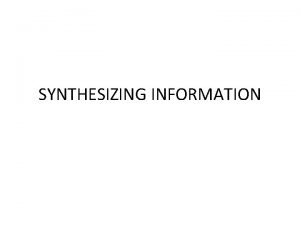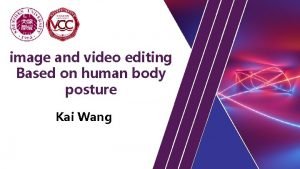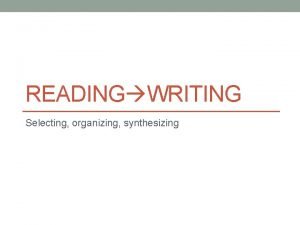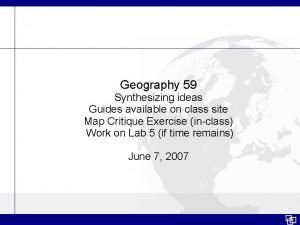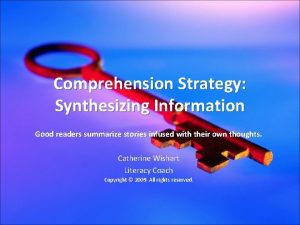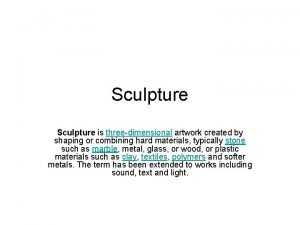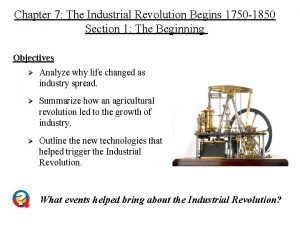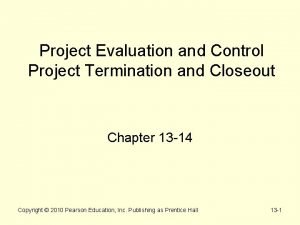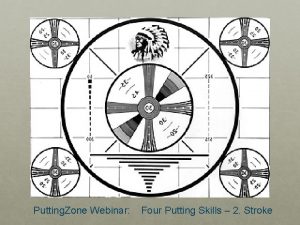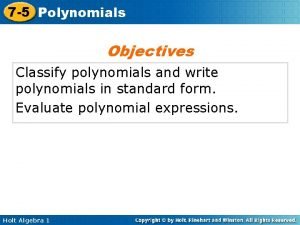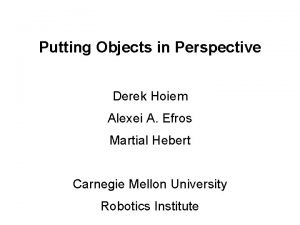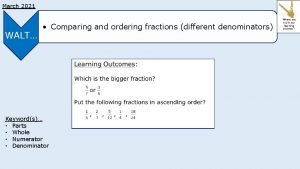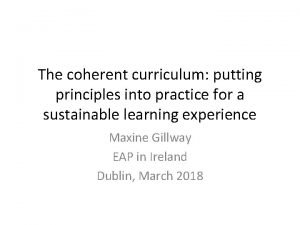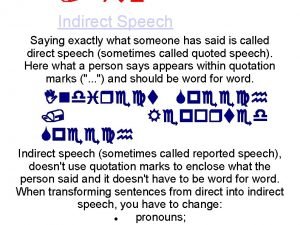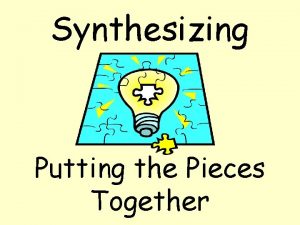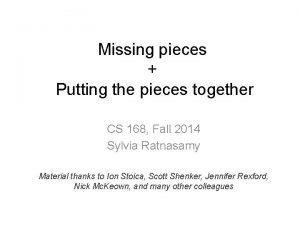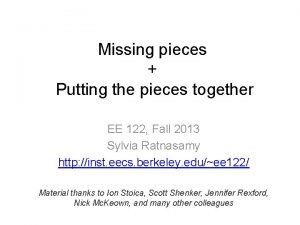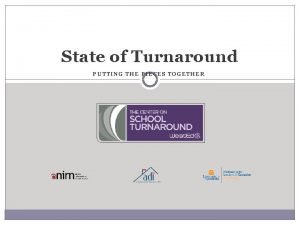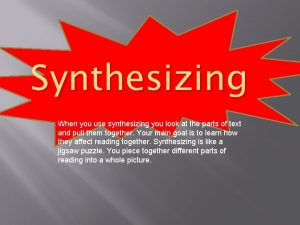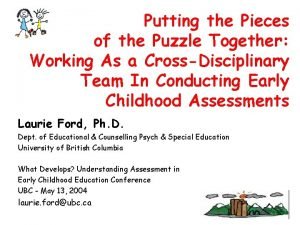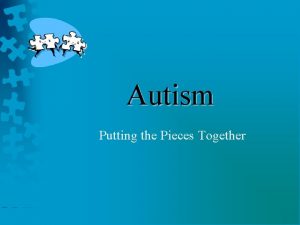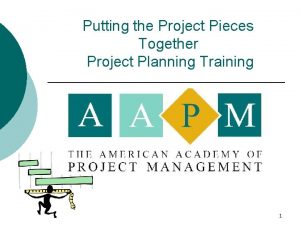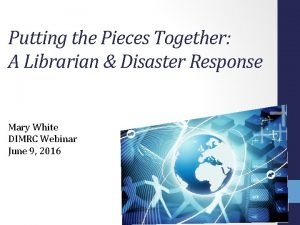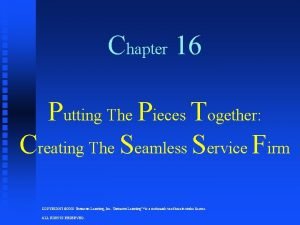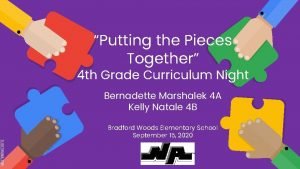Synthesizing Putting the Pieces Together What Exactly Is















































- Slides: 47

Synthesizing Putting the Pieces Together

What Exactly Is Synthesizing?

“Synthesis is about organizing the different pieces to create a beautiful mosaic, a meaning, a beauty, greater than the sum of each shiny piece. ” Ellin Keene

“Synthesis is a matter of seeing how the details fit together to draw a conclusion, how the details solve a mystery, or how they bring characters (and readers) to a new understanding. Synthesis involves an “aha” moment, when, all of a sudden, everything becomes clear. ” Nancy Boyles

or simply put…

“Synthesizing is like putting a puzzle together. You have to sort out your thinking and put it in the right place. ” Clay

“Synthesis is like throwing a rock into a pond: first there’s the splash, and then the water ripples out, making little waves that get bigger and bigger. ” Ellin Keene

“Synthesizing is like baking a cake—all the different parts mixed together become a whole new thing. ” David Harris, Strategies That Work

Why do we need to put the pieces together anyway?

“In order to construct any kind of meaning in our literacy learning and our life learning, we must find ways to cull and prune the details with which we are bombarded. We must reorganize and create our own explanations for what we are learning, our own definitions of our lives at any particular juncture. ” Ellin Keene

We teach the children to take what they read and… Look for important issues, themes, and ideas Ask questions Create images, relate what they read to prior knowledge Draw conclusions Make judgments Predict

The key is then keeping track of what it all means…

Let’s Try Our Hand at Synthesizing!

1. Read the excerpt from The Cay that is found on the overhead. 2. Record your thoughts on paper. 3. Read the next part and record your thoughts now. 4. Read the last part and record your final thoughts. 5. How did your thinking change as you read? 6. What strategies did you use to understand the story?

How do we teach the students which piece goes where?

1. Teaching synthesis is a challenge. It requires more think-aloud modeling on the teacher’s part, and more conferences focused on helping children think aloud than other comprehension strategies. Ellin Keene

2. Begin a study on synthesis by helping students to see how readers monitor overall meaning, important concepts, and themes as they read, understanding that their thinking evolves in the process.

Your goal is to get the reader engaged. 3. As you read, model stopping now and then to consider what is important to remember. Distinguish between facts that are interesting and those that are important.

4. Help students to learn to retell the most important parts of a story. Tell what’s important in a way that makes sense, without telling too much. Gradually release responsibility …

Stop now and then to ask the students to get with partners to synthesize the text so far, then collaborate and chart the students’ thoughts. Ask students to read independently for five or ten minutes, then stop and find a partner and retell in their own words. Ask students who are reading the same text to synthesize it when they finish, then get together and compare thinking. Debbie Miller

5. Have students create a simple summary. In fiction this might be meeting the characters, figuring out where the story took place, and determining the plot.

Don’t Get the Pieces Confused!!

Synopsizing vs. Summarizing Don’t let students become victims of the “and then he…” syndrome! Students need to understand that summarizing is a strategy that allows us to categorize and classify the information gathered as readers, sorting out significant ideas, events, and other pieces of information. When reading a long piece, the reader needs to pause and regroup every so often, making notes as necessary.

Summarizing vs. Synthesizing Summarizing is identifying key points and organizing thoughts, a listing of the parts. Summarizing usually occurs at the end. Synthesizing is the creation of a whole. It goes on throughout the process of reading—not just at the end. It is bringing together different ideas and facts and weaving them together into a tapestry, something much larger than all the threads. Ellin Keene

“Summarizing is part of synthesis. You can’t synthesize if you don’t know how to summarize. Summarizing is the act of briefly presenting the main point. When teaching summary, teachers should encourage readers to retell information by including important ideas but not telling too much. ” Stephanie Harvey

6. Have students capitalize on opportunities to share, recommend, and criticize books they have read.

7. Have students extend their synthesis of the literal meaning of a text to the inferential level. Clues Along the Way The teacher should provide opportunities for the students to stop at certain points in the reading to write down their thoughts. Fables are great texts to use when beginning this process.

8. Consider having students bring in a current article each week. Ask them to read the article, tape it to a notebook page, and write a brief synthesis that includes their own take on the article. Stephanie Harvey, Nonfiction Matters

The Pieces Will Only Fit Together If…

The process of synthesizing occurs during reading when proficient readers… monitor the overall meaning, important concepts and themes in the text, and are aware of text elements and patterns in fiction and nonfiction, helping them predict and understand the overall meanings or themes.

Also during reading, proficient readers should… attend to character, setting, conflict, sequence of events, resolution, and theme in fiction, and text patterns such as description, chronological, cause and effect, comparison/contrast, and problem/solution in nonfiction. They use this knowledge to make overall decisions about the meaning of a text. revise their cognitive syntheses as they read.

The process of synthesizing occurs after reading when proficient readers… use synthesis to share, recommend, and critically review books they have read. purposefully use synthesis to better understand what they have read. are able to express, through a variety of means, a synthesis of what they have read, including ideas and themes relevant to the overall meaning from the text.

How do we prompt the students as they try to get the pieces to fit? In just a few sentences, describe this text as if you are discussing it with someone who has never read it. If you were explaining this story to a younger child, what would you say? At what point did you say to yourself, “AHA, now I get it!”? What strategies helped you to figure out the meaning of the text?

Also… What do you think might be on a test about this reading? Did this reading change or confirm what you thought about _______? Explain. How did you go about figuring this out? Imagine that you are giving a talk to your class about ____. Using information from the text, write two ideas you should use in this speech. Can you show me a place in the text where your thinking changed? Do you have some new ideas or information?

What tools can help put the pieces together?

Learning Strategies Written response to literature - Charting thinking records - Post-it notes - Double entry journals - Letters to other readers and writers - Quick write - Timelines Oral responses - Four way share - Think-pair-share - Book clubs - Strategy study groups Keene, 2001

Main Ideas Details Lingering Thoughts

Opinion Before Reading New Response

Facts Questions Responses

Summary Response

Quote or picture from text New ideas

Content (Facts) Process (Thinking) Craft (Writing) • 63 moons and climbing • Two new moons are circling Uranus • Uranus is the seventh planet from the sun. • Moonstruck means obsessed (inferring) • 63 means number of moons, maybe there are more • Just a question to clarify. Are satellites and moons the same thing? • Wow! When it said littering the starry skies, they were very strong words that painted a picture in my mind. • When the lead asks a question, it pulls you into the article.

Author: Title: Characters: Setting: Plot: Beyond the literal interpretation question: Possible answers: Synthesis:

What Does the Finished Product Look Like?

When readers put all of the pieces together, they can… identify the essential story line and ask, “What does it all mean to me? ”. generate questions, apply background knowledge, and discuss it with others. Through the process of synthesizing, their thinking deepens and their understanding grows.

You know that students have mastered synthesizing when, just as they manipulate hundreds of puzzle pieces to form a new picture, they can arrange fragments of information until they see a new pattern take shape. Stephanie Harvey

Guiding to Completion . Booth, David and Larry Swartz. Literacy Techniques. Ontario, Canada: Pembroke Publishers Limited, 2004 Boyles, Nancy N. Constructing Meaning Through Kid-Friendly Comprehension Strategy Instruction. Gainesville, FL: Maupin House, 2004. Harvey, Stephanie. Nonfiction Matters. Portland, Maine: Stenhouse Publishers, 1998. Harvey, Stephanie and Anne Goudvis. Strategies That Work: Teaching Comprehension to Enhance Understanding. York, ME: Stenhouse Publishers, 2000. Keene, Ellin and Susan Zimmerman. Mosaic of Thought: Teaching Comprehension in a Reader’s Workshop. Portsmouth, NH: Heinmann, 1997. Miller, Debbie. Reading with Meaning. Portland, Maine: Stenhouse Publishers, 2002. Zimmerman, Susan and Chryse Hutchins. 7 Keys to Comprehension: How to Help Your Kids Read It and Get It! New York, NY: Three Rivers Press, 2003.
 After putting the pieces together, what do they look like?
After putting the pieces together, what do they look like? Putting the pieces together case study answer key
Putting the pieces together case study answer key Putting two words together
Putting two words together Package mypackage class first class body
Package mypackage class first class body Introduction bridge examples
Introduction bridge examples Strategic organization helps speeches be more effective
Strategic organization helps speeches be more effective Putting it all together
Putting it all together Putting it all together motion answer key
Putting it all together motion answer key Practice putting it all together part 1 fill in the blank
Practice putting it all together part 1 fill in the blank Putting things together is called
Putting things together is called Putting letters together
Putting letters together Gardner 5 minds
Gardner 5 minds Synthesizing and citing sources: mastery test
Synthesizing and citing sources: mastery test Synthesising reading strategy
Synthesising reading strategy Synthesizing ideas in an informational text
Synthesizing ideas in an informational text Analyzing and synthesizing
Analyzing and synthesizing Process of synthesizing information
Process of synthesizing information Caroline chan nude
Caroline chan nude Synthesizing in reading
Synthesizing in reading Pengertian ringkasan adalah
Pengertian ringkasan adalah Flow map
Flow map Reading strategies synthesizing
Reading strategies synthesizing What fires together wires together
What fires together wires together Putting the enterprise into the enterprise system
Putting the enterprise into the enterprise system Oncology nursing society putting evidence into practice
Oncology nursing society putting evidence into practice Putting people first 2007
Putting people first 2007 Putting on the new man
Putting on the new man Sculpture is created by shaping or combining the materials
Sculpture is created by shaping or combining the materials Putting-out system
Putting-out system Putting stance width
Putting stance width Putting-out system
Putting-out system Putting-out system
Putting-out system Project evaluation and control
Project evaluation and control Putting zone
Putting zone Price fences marketing
Price fences marketing The order of putting on ppe
The order of putting on ppe Putting it into practice
Putting it into practice Classify each polynomial according to its degree and type.
Classify each polynomial according to its degree and type. What is nasreen putting chocolate on
What is nasreen putting chocolate on Put to death the old man
Put to death the old man Putting objects in perspective
Putting objects in perspective Ordering fractions with different denominators
Ordering fractions with different denominators Putting prevention into practice
Putting prevention into practice Putting principles into practice
Putting principles into practice Putting the enterprise into the enterprise system
Putting the enterprise into the enterprise system When was the loom invented
When was the loom invented Human resources and job design in operations management
Human resources and job design in operations management Saying exactly what someone has said is called
Saying exactly what someone has said is called
